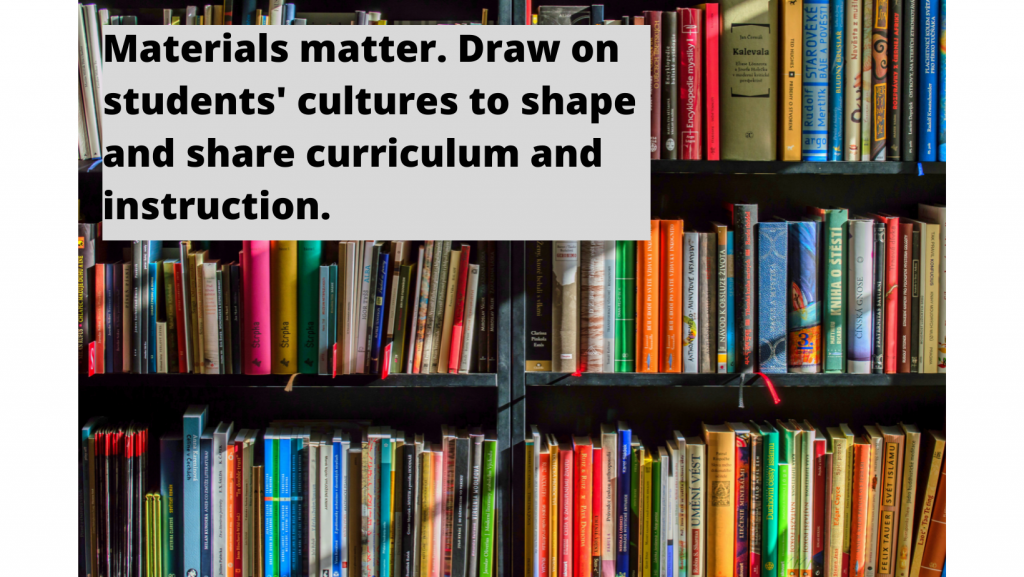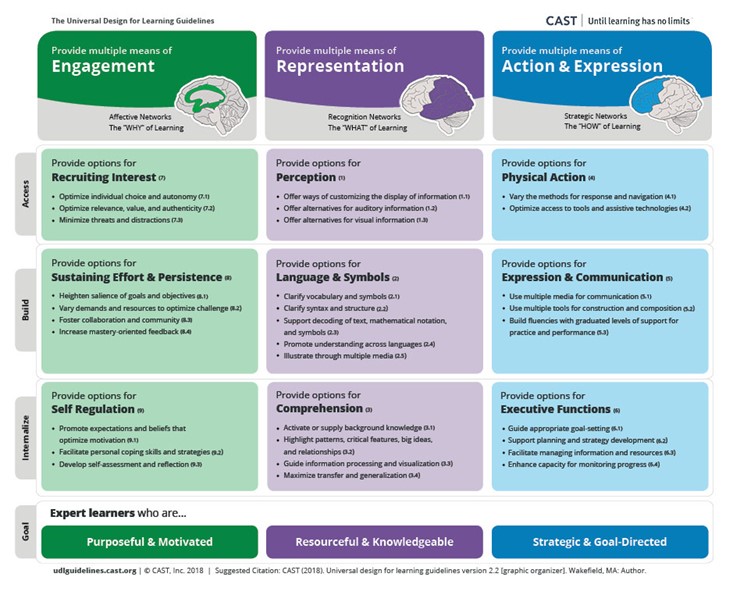Inclusive Materials and Content

Introduction
In the previous module, we learned about the importance of culturally responsive and inclusive teaching, reflected on our own identities and those of our students, and drafted diversity and inclusion statements.
In this second module of the course, we’ll examine our curriculum and materials and look at how using culturally responsive and inclusive materials can impact students. We’ll use a scorecard to assess current curriculum and materials and develop an action plan for updates.
The objectives for this module are:
- Participants will state the importance of culturally responsive curriculum and its impact on student learning outcomes
- Participants will use a scorecard to review and assess current curriculum materials and content for culturally responsive pedagogy
- Participants will use the scorecard data to determine areas of alignment and gaps in culturally responsive pedagogy
- Participants will formulate an action plan for updating their curriculum to be more culturally responsive
Faculty Demographics
In our last module, we looked at student demographics at the university. Now let’s look at the demographics of our faculty and see how they compare to student demographics.
Click the arrows in the slide show below to view the graphics. Click the double-headed arrow in the lower right corner to enlarge the slide show.
At our university, 64.8% of undergraduate students and 50.6% of graduate students are minorities, but only 29.5% of faculty are minorities (USMD, 2021).
Though some faculty at the university already employ many culturally responsive practices in their work with students, the marked difference in the backgrounds of students and faculty underscores the need for culturally responsive and inclusive teaching.
Reflection
Before we examine our own curriculum and materials, take a moment to recall a course you took as a student and to think about what materials were used. Consider a course and respond briefly to the prompts below.
Universal Design for Learning
A powerful model for meeting the needs of each individual student, “Universal Design for Learning (UDL) is a framework to improve and optimize teaching and learning for all people based on scientific insights into how humans learn” (CAST, 2021).
UDL is structured around three main areas:
- Affective Networks: The Why of Learning or Engagement
- Recognition Networks: The What of Learning or Representation
- Strategic Networks: The How of Learning or Action & Expression
(CAST, 2020)
Explore the graphic below to learn specific strategies you can use to apply UDL to your instruction. Click the graphic to zoom in.

Universal Design for Learning and Culturally Responsive Teaching
How do Universal Design for Learning and Culturally Responsive Teaching connect? According to Kieran & Anderson (2018), “both USL and CRT encourage teaching to proactively consider educational approaches that should result in increased student engagement and learning.
Open each item in the accordion to learn more about the connections between UDL and CRT.
Inclusive Design
A key part of creating a culturally responsive learning environment is to carefully consider what materials are used. As you select course content, include a wide range of perspectives in your materials. This helps show students that multiple views are valued, encouraging them to share their viewpoints and experiences to enrich the learning community.
As you select content, consider the following prompts:
- How has the course been organized in the past? Are ideas or groups excluded or distorted?
- What new research could be added to address historic exclusions?
- How might the course change if new materials are added?
- What implications might changing this course have for other courses in the curriculum?
- How can new material be fully integrated into the course (rather than tacked on)?
- What teaching strategies will be needed to support the new material?
(University of Washington, 2021)
Rudine Sims Bishop’s “Mirrors, Windows, and Sliding Glass Doors”
Rudine Sims Bishop’s, Professor Emerita of Education at Ohio State University, developed the concept of “Mirrors, Windows, and Sliding Glass Doors.” This analogy is used to demonstrate the importance of students seeing themselves reflected in course materials while also having the opportunity to look into new worlds. Watch the video for more about this idea.
Examining Curriculum
Now that we’ve learned about the importance of a culturally responsive and inclusive curriculum and materials, we’ll examine a sample curriculum.
Scorecard
Let’s take a look at the scorecard we’ll use for this process.
This scorecard was adapted from the scorecard developed by the Metropolitan Center for Research on Equity and Transformation of schools “to help parents, teachers, students, and community members to determine the extent to which their schools’ English Language Arts curricula are (or are not) culturally responsive” (Bryan-Gooden et al, 2019, pg. 3). In creating and using this tool, the hope is that “this process will provoke thinking about how students should learn, what they should learn, and how curriculum can be transformed to engage students effectively” (Bryan-Gooden et al, 2019, pg. 3).
| Statements | Excellent (+2) | Acceptable (+1) | Unclear (-1) | Unacceptable (-2) |
| Decolonization, Power, and Privilege | ||||
| 1. Curriculum highlights non-dominant populations and their strengths and assets, so that students of diverse race, class, gender, ability, and sexual orientation can relate and participate fully. | ||||
| 2. The curriculum communicates an asset-based perspective by representing people of diverse races, classes, genders, abilities and sexual orientations through their strengths, talents and knowledge rather than their perceived flaws or deficiencies. | ||||
| 3. The curriculum does not communicate negativity or hostility toward people of marginalized backgrounds through verbal or nonverbal insults, slights or snubs. | ||||
| 4. Curriculum and instructional activities promote or provoke critical questions about the societal status quo. They present alternative points of view as equally worth considering. | ||||
| Centering Multiple Perspectives | ||||
| 5. The curriculum recognizes the validity and integrity of knowledge systems based in communities of color, collectivist cultures, matriarchal societies, and non-Christian religions. | ||||
| 6. The curriculum presents different points of view on the same event or experience, especially points of view from marginalized people/communities. | ||||
| Connect Learning to Real Life & Action | ||||
| 7. The curriculum provides avenues for students to connect learning to social, political, or environmental concerns that affect them and their lives and contribute to change. | ||||
| 8. The curriculum encourages students to take actions that combat inequity or promote equity within the school or local community | ||||
Adapted from Bryan-Gooden, J., Hester, M., and People, L. (2019). Culturally Responsive curriculum scorecard. The Metropolitan Center for Research on Equity and the Transformation of Schools. https://steinhardt.nyu.edu/sites/default/files/2020-12/CRE%20Scorecard%20Revised%20Aug%202020.pdf
Scoring categories
Text in this section is taken from Bryan-Gooden, J., Hester, M., and People, L. (2019). Culturally Responsive curriculum scorecard. The Metropolitan Center for Research on Equity and the Transformation of Schools. https://steinhardt.nyu.edu/sites/default/files/2020-12/CRE%20Scorecard%20Revised%20Aug%202020.pdf
Click the titles in the accordion below to view descriptions for each scoring category.
Scoring Guidelines
Text in this section is taken from Bryan-Gooden, J., Hester, M., and People, L. (2019). Culturally Responsive curriculum scorecard. The Metropolitan Center for Research on Equity and the Transformation of Schools. https://steinhardt.nyu.edu/sites/default/files/2020-12/CRE%20Scorecard%20Revised%20Aug%202020.pdf
After reading the explanation for the scorecard provided in the previous section, please use the following categories to indicate how satisfied you are with the curriculum.
Click each title in the accordion below to view descriptions for each scoring level.
Apply the Scorecard
We will now apply the scorecard to a sample curriculum.
Review the list of materials in this English 101 course. Use the scorecard to score the course.
Reflect
After reviewing and scoring the sample curriculum, reflect on the process using the following prompts:
Assessing your own curriculum
Now that we’ve looked at an example curriculum, let’s turn our focus to the curriculum and materials of one of your own courses. Select a course that you have developed a curriculum and selected materials for and plan to teach in an upcoming semester. Then, use the scorecard to evaluate it for cultural responsiveness.
Action Planning
After reviewing and scoring your curriculum, consider what changes you might make to it to make it more culturally responsive. Develop an action plan with at least three steps for updating your curriculum. Submit your action plan in the Deliverables section of the course.
